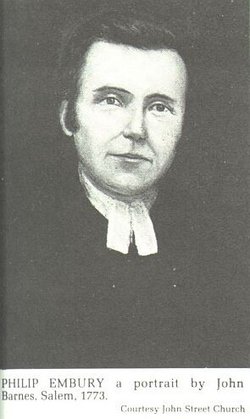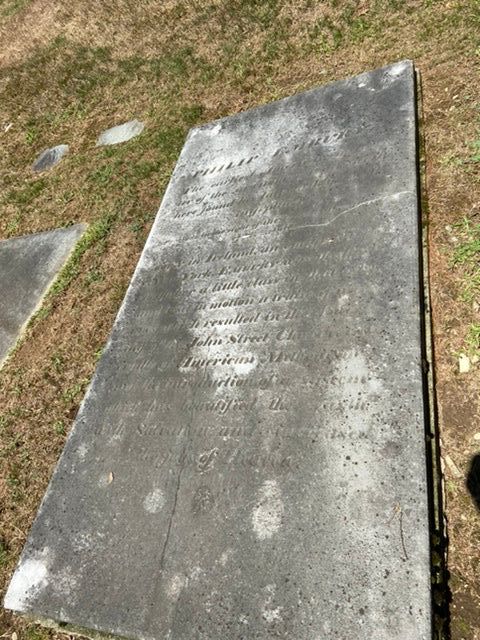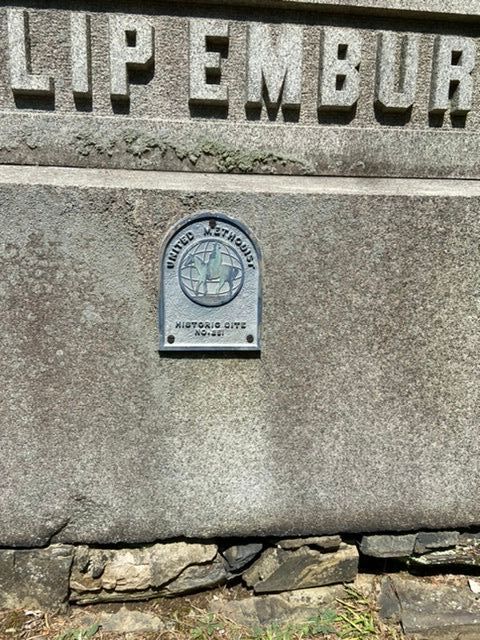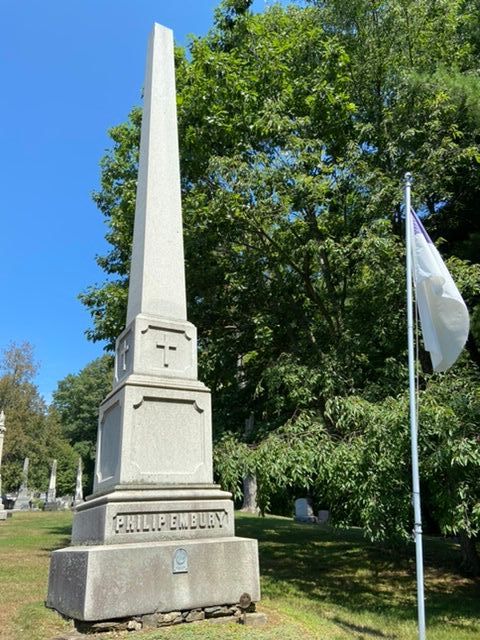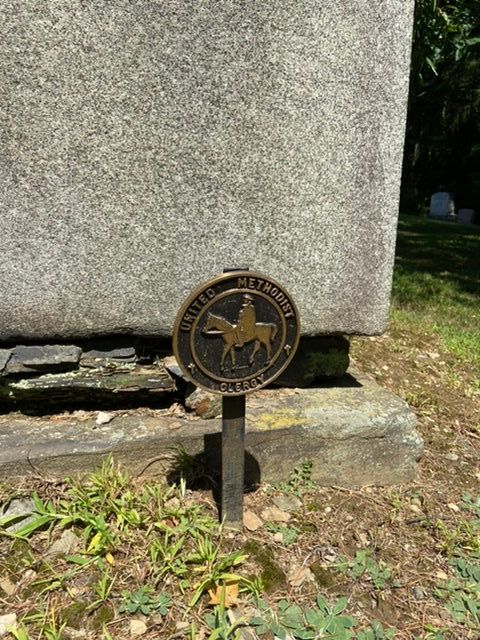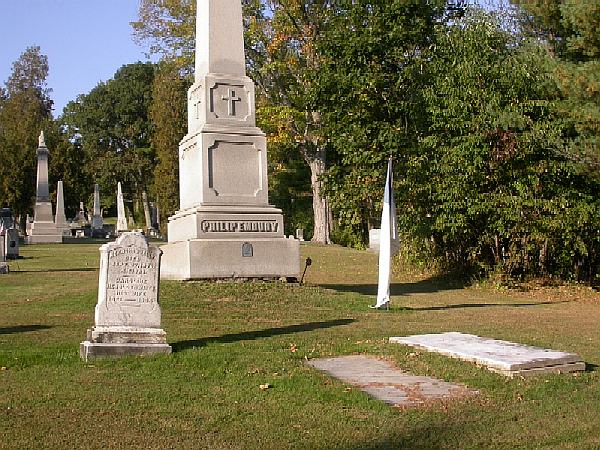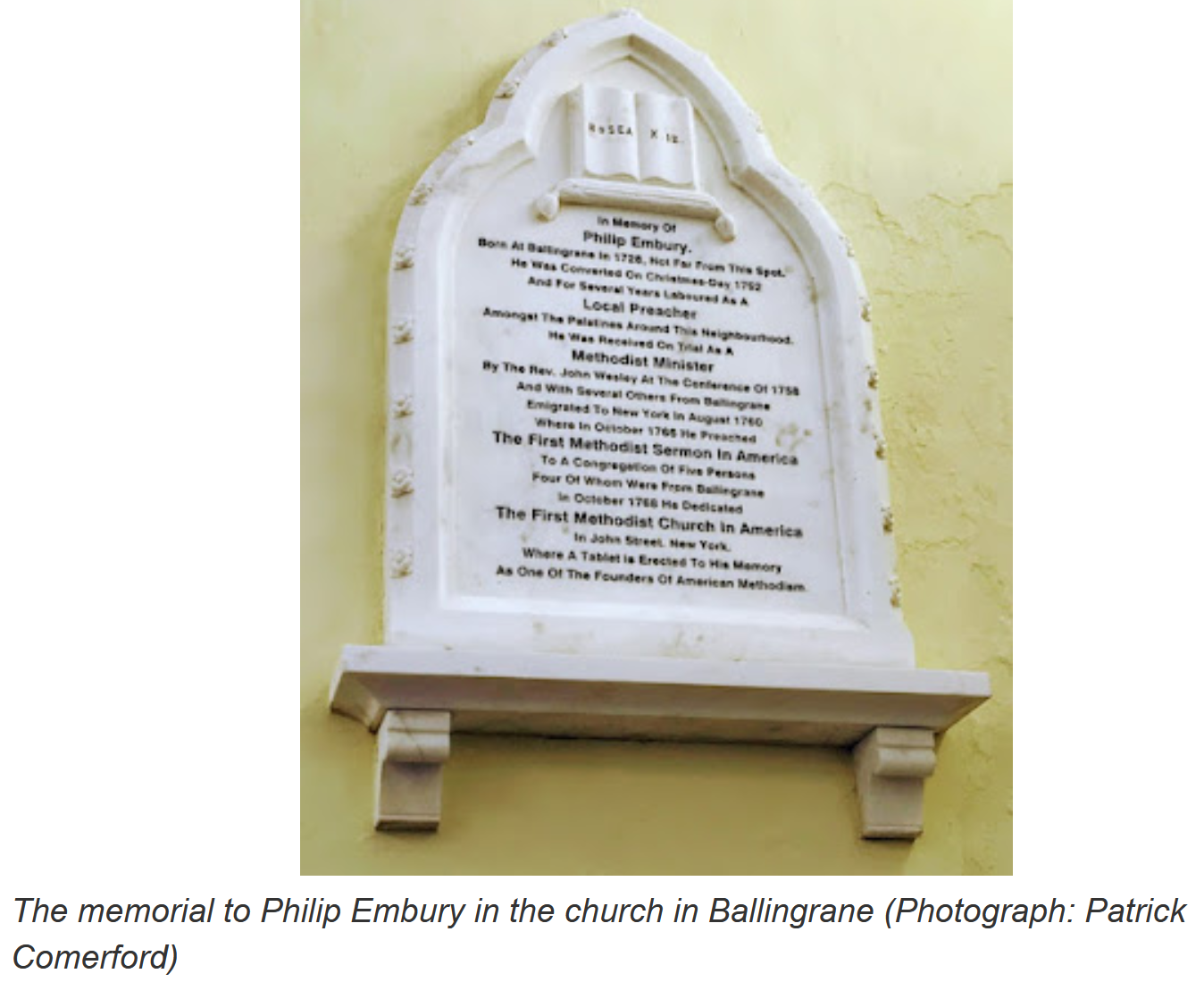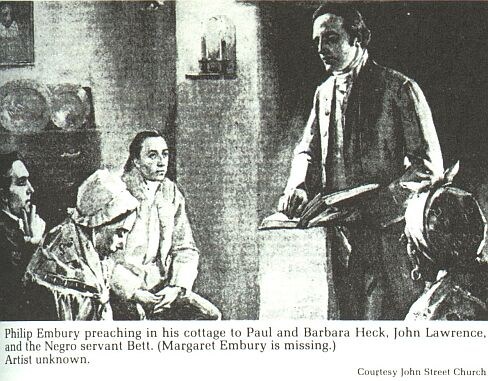History as written by Robert Switzer...
First Generation: Reverend Philip Embury
1. Reverend Philip Embury was born 1 on Sep 1 1728 in Ballingrane, County Limerick, Ireland.
He died in 1773 in Camden Valley, Charlotte, New York, USA and was buried in New Woodlands Cemetery, Cambridge, New York, USA.
Philip was a lay preacher for the Methodists on the Southwell Estate. He had found his personal salvation on Christmas day in 1752.
Philip was also working as a carpenters apprentice and living at home. By 1758 he was engaged in the absorbing task of building the first chapel for the Methodists on the Southwell Estate.
It was on the square at Courtmatrix near the home of his Switzer cousins, with whom he may have lived while working on the building.
It was at this time that the 30 year old carpenter-preacher became seriously interested in 16 year old Margaret. It is believed that Philip and Margaret set up housekeeping in the Embury family home, built by Philip's father, in Ballingrane, upon their marriage.
In 1759, Philip became a freeholder but even before this it is believed that he was weighing the pros and cons of leaving the only home he had known as in October, 1759, he had taken inventory of his property, measuring in acres, roods and perch, the size of each field.
On a day in June 1760, a crowd of kinfolk and Methodist friends from the area gathered at the Customs House Quay in Limerick City, to bid farewell to a popular group of young people, among them their promising young preacher, Philip and his wife Margaret Switzer (Margaret was pregnant).
They sailed on the ship Perry and it took 9 weeks to reach New York from Limerick, this was only 3 days less than it had taken the Mayflower to bring the Pilgrim Fathers in 1620. Upon arrival, it is said that Philip had to be carried ashore, due to illness, and there is a chair at John Street Methodist Church, which according to tradition is the chair he was carried ashore in.
A year before their arrival Major General James Wolfe had landed his army on the Plains of Abraham, above Quebec and, in the battle in which he and the French General Montcalm lost their lives, won Canada for England.
Three weeks after arriving the English under General Jeffrey Amherst captured Montreal, on September 8, 1760. The old church register of Trinity Lutheran, at Christmas 1760 shows Philip in attendance, Margaret is not in attendance at this time, probably because she was expecting their first child at any time. At Easter 1761, she was listed in the register.
Philip and his brother John penned several applications for vacant land, for the Palatines, on which to settle.
Philip preached in his home and taught school. Philip is known, along with his cousin Barbara Heck, as the founders of Methodism in North America. His home soon became too small to fit all into, to hear him preach, so money was raised and a Church was built in 1768 and 1769.
This church became known as John Street Church, at which the pulpit from which Philip preached, is still located for visitors to see.
This was the first Methodist Church of North America.
Upon the property they purchased for the church, stood a house, which the Methodists used as a parsonage, with Philip and Margaret and their 2 remaining small children, Samuel and Catherine, moved into sometime in 1768. Philip was working on finishing the interior of the church right up until a few days from departing to the north in April, 1770.
By May of 1770, likely living in tents, the Palatines, including Philip and Margaret commenced the arduous labor of clearing, tilling and erecting buildings. Even before 1770, there was a sawmill about 2 miles south of where Philip settled, on a stream at an old Indian Village named Pompanac, where the settlers could get cut lumber for floors, doors, interior finish and furniture.
When leaving New York and going to Camden Valley, Philip was named leader and under his leadership began to choose each mans fair share of the land allotted them. Philip was also appointed, by the Provincial Governor, Justice of the Peace for Albany County.
When Charlotte County came into being in 1772, his appointment of Justice was renewed and he was also designated as a commissioner on the 13 man Road Commission. It took some time to get a written lease for their lands, but it finally came from Duane on May 1, 1773.
Philip and a Thomas Ashton formed together a Methodist Society at Ashgrove, and a class in West Camden. Embury was preacher and class leader and Ashton Stewart and leading layman. They planted the seeds for the first Methodist Church north of New York.
In August, 1773, while working in his fields, Philip was stricken with pluerisy and after a few days illness, died. Upon his death Philip was buried in Father Biningers field in Camden Valley, New York.
On June 6, 1832, the Troy Conference, meeting at Ashgrove, had Philip's bones exhumed and moved from the secluded cemetery on the Bininger farm in the Valley to Ashgrove Burying Ground. In the centennial year of 1866, 100 years after he had preached his first sermon, The Troy Conference, meeting in Cambridge, New York, had Philips remains moved again to the New Woodlands Cemetery in Cambridge, New York.
Philip Embury, pioneer Methodist, was born in Ballygaran, Ireland, Sept. 21, 1729; son of German emigrants from the Palatinate. He was a carpenter with a fair education. Under the preaching of Wesley he was influenced to embrace the Methodist faith in 1752, and he became a local preacher in 1758.
In 1760 he immigrated to America and worked as a carpenter in New York city. In 1766, after hearing Barbara Heck preach, his religious ardor revived and he held services in his house on Barrack street and in a rigging loft on the east side of the city in William street.
His congregation is claimed to have been the first assembly of Methodists in America.
He built the first Methodist church, on John street in 1768, and preached there one year. He removed to Camden, Washington county, N.Y., in 1769, where he worked as a carpenter and preached every Sunday. At Ash Grove, near his house, he organized the first Methodist society in northern New York, afterward in the Troy conference. A monument was erected in 1873 over the spot in Woodland cemetery, Cambridge, N. Y., to which his remains had been removed in 1866. He died in Camden, N.Y., in August, 1775.
"History of Washington Academy and Bench and Bar of Washington County, New York (The Gibson Papers)" by William H. Hill. pp. 96-97.
On 31st day of October, 1758, 30 year old Philip Embury of Ireland, married 16 year old Margaret Switzer of Court-Matrix, a descendant of one of the Palatines. In 1763 a group petitioned for land patent now known as Wilson's Patent. Names included: John Embury, Philip Embury, David Embury, Peter Embury, James Wilson, George Wilson, Sam Wilson. It was not until 1770 that Embury with his wife & children and his colony left New York City and settled in the valley of Camden, in the town of Salem. Peter Switzer also had a share.
On settling in Camden, Philip Embury seems to have joined with Peter Switzer, a brother of his wife, in the erection of a house which they occupied together, and where he lived the remainder of his life.
Embury died in August, 1773, caused by overwork in the hay field in a day of great heat. His widow, Margaret Switzer, survived him, and three children, two having "gone before," dying in New York City:
Catharine Elizabeth b. Nov. 19, 1760, lived nearly two years. John Albert died after reaching 3 years of age.
Three more children were born before leaving NYC:
Samuel was 5 yrs old when his father died; Catharine Elizabeth named after their first born, was nearly three; Anna was eleven months.
Philip their youngest child, was only one born after their settlement in Salem, on April 13, 1772.
After Embury's death, his widow removed to a house on the opposite side of the Batten Kill from the Switzer place, and about a mile on the stream below. In 1778, Mrs. Embury, with her remaining two children, accompanied by many of the associates and settlers of Camden, succeeded in making their way to Canada through Vermont. She reached Canada safely, and never returned to Camden.
"History of Washington Co., NY" 1878. p. 274.
Embury formed a 'class" of Methodism at Ashgrove in Camden. Names on oldest records show: Philip Embury, Margaret Embury, Peter Switzer, Anna M. Switzer, Christopher Switzer. Male membership in 1787 included Abram Hodge.
Philip married Margaret Switzer, daughter of Johann Christopher Schweitzer and Catherine Elizabeth Ruckle, on Oct 31 1758 in Rathkeale, Limerick, Ireland.
Margaret was born in 1743 in Courtmatrix, County Limerick, Ireland and was christened 6 on May 16 1743 in Rathkeale, County Limerick, Ireland. She died in 1807 in Augusta Twp., Ontario, Canada and was buried in Blue Church Cemetery, Prescott, Ontario, Canada.
Upon the death of Philip Embury, Margaret's first husband, she moved into the new house that Philip had been building and leased the farm to her brother Peter.
Margaret found little comfort in her new home, as sometime between the death of Philip and July 1775 her two youngest children died and where buried near the new house, what is now on the north side of the road that connects Eaglesville and the present Cambridge-Arlington road.
In the 1960's there could still be seen a mound with a few trees and shrubs and some dilapidated tombstones. Soon after this, Margaret and her brother-in-law, David Embury, as executors of Philip's estate, sold his share of the Embury-Wilson Patent and the new house to a Francis Nicholson from Tipperary County, Ireland. He paid 130 pounds for the 4 lots which had been Embury's. John Lawrence was witness to the document. Shortly after this sale Margaret and John Lawrence married.
Philip and Margaret had the following children:
Catherine Elizabeth Embury was born in 1760 and was christened on Jan 9 1761 in Trinity Lutheran Church . She died in 1762.
John Albert Embury was born in and was christened on Oct 10 1762 in Trinity Lutheran Church. He died in 1766.
Samuel Embury was born in 1765 and died in 1853.
Catherine Embury was born in 1767 and died in 1831.
Anna Embury was born in 1769 in New York, New York, USA. She died in 1775 in Camden Valley, New York, USA.
Anna is buried on the north side of the road connecting Eaglesville and highway 313 in New York State.
Philip Embury was born in 1772 in Camden Valley, New York, USA. He died in 1775 in Camden Valley, New York, USA.
Buried along with his sister Anna on the north side of the road connecting Eaglesville and highway 313 in New York State.
History as written by Robert Switzer...
First Generation: Reverend Philip Embury
1. Reverend Philip Embury was born 1 on Sep 1 1728 in Ballingrane, County Limerick, Ireland.
He died in 1773 in Camden Valley, Charlotte, New York, USA and was buried in New Woodlands Cemetery, Cambridge, New York, USA.
Philip was a lay preacher for the Methodists on the Southwell Estate. He had found his personal salvation on Christmas day in 1752.
Philip was also working as a carpenters apprentice and living at home. By 1758 he was engaged in the absorbing task of building the first chapel for the Methodists on the Southwell Estate.
It was on the square at Courtmatrix near the home of his Switzer cousins, with whom he may have lived while working on the building.
It was at this time that the 30 year old carpenter-preacher became seriously interested in 16 year old Margaret. It is believed that Philip and Margaret set up housekeeping in the Embury family home, built by Philip's father, in Ballingrane, upon their marriage.
In 1759, Philip became a freeholder but even before this it is believed that he was weighing the pros and cons of leaving the only home he had known as in October, 1759, he had taken inventory of his property, measuring in acres, roods and perch, the size of each field.
On a day in June 1760, a crowd of kinfolk and Methodist friends from the area gathered at the Customs House Quay in Limerick City, to bid farewell to a popular group of young people, among them their promising young preacher, Philip and his wife Margaret Switzer (Margaret was pregnant).
They sailed on the ship Perry and it took 9 weeks to reach New York from Limerick, this was only 3 days less than it had taken the Mayflower to bring the Pilgrim Fathers in 1620. Upon arrival, it is said that Philip had to be carried ashore, due to illness, and there is a chair at John Street Methodist Church, which according to tradition is the chair he was carried ashore in.
A year before their arrival Major General James Wolfe had landed his army on the Plains of Abraham, above Quebec and, in the battle in which he and the French General Montcalm lost their lives, won Canada for England.
Three weeks after arriving the English under General Jeffrey Amherst captured Montreal, on September 8, 1760. The old church register of Trinity Lutheran, at Christmas 1760 shows Philip in attendance, Margaret is not in attendance at this time, probably because she was expecting their first child at any time. At Easter 1761, she was listed in the register.
Philip and his brother John penned several applications for vacant land, for the Palatines, on which to settle.
Philip preached in his home and taught school. Philip is known, along with his cousin Barbara Heck, as the founders of Methodism in North America. His home soon became too small to fit all into, to hear him preach, so money was raised and a Church was built in 1768 and 1769.
This church became known as John Street Church, at which the pulpit from which Philip preached, is still located for visitors to see.
This was the first Methodist Church of North America.
Upon the property they purchased for the church, stood a house, which the Methodists used as a parsonage, with Philip and Margaret and their 2 remaining small children, Samuel and Catherine, moved into sometime in 1768. Philip was working on finishing the interior of the church right up until a few days from departing to the north in April, 1770.
By May of 1770, likely living in tents, the Palatines, including Philip and Margaret commenced the arduous labor of clearing, tilling and erecting buildings. Even before 1770, there was a sawmill about 2 miles south of where Philip settled, on a stream at an old Indian Village named Pompanac, where the settlers could get cut lumber for floors, doors, interior finish and furniture.
When leaving New York and going to Camden Valley, Philip was named leader and under his leadership began to choose each mans fair share of the land allotted them. Philip was also appointed, by the Provincial Governor, Justice of the Peace for Albany County.
When Charlotte County came into being in 1772, his appointment of Justice was renewed and he was also designated as a commissioner on the 13 man Road Commission. It took some time to get a written lease for their lands, but it finally came from Duane on May 1, 1773.
Philip and a Thomas Ashton formed together a Methodist Society at Ashgrove, and a class in West Camden. Embury was preacher and class leader and Ashton Stewart and leading layman. They planted the seeds for the first Methodist Church north of New York.
In August, 1773, while working in his fields, Philip was stricken with pluerisy and after a few days illness, died. Upon his death Philip was buried in Father Biningers field in Camden Valley, New York.
On June 6, 1832, the Troy Conference, meeting at Ashgrove, had Philip's bones exhumed and moved from the secluded cemetery on the Bininger farm in the Valley to Ashgrove Burying Ground. In the centennial year of 1866, 100 years after he had preached his first sermon, The Troy Conference, meeting in Cambridge, New York, had Philips remains moved again to the New Woodlands Cemetery in Cambridge, New York.
Philip Embury, pioneer Methodist, was born in Ballygaran, Ireland, Sept. 21, 1729; son of German emigrants from the Palatinate. He was a carpenter with a fair education. Under the preaching of Wesley he was influenced to embrace the Methodist faith in 1752, and he became a local preacher in 1758.
In 1760 he immigrated to America and worked as a carpenter in New York city. In 1766, after hearing Barbara Heck preach, his religious ardor revived and he held services in his house on Barrack street and in a rigging loft on the east side of the city in William street.
His congregation is claimed to have been the first assembly of Methodists in America.
He built the first Methodist church, on John street in 1768, and preached there one year. He removed to Camden, Washington county, N.Y., in 1769, where he worked as a carpenter and preached every Sunday. At Ash Grove, near his house, he organized the first Methodist society in northern New York, afterward in the Troy conference. A monument was erected in 1873 over the spot in Woodland cemetery, Cambridge, N. Y., to which his remains had been removed in 1866. He died in Camden, N.Y., in August, 1775.
"History of Washington Academy and Bench and Bar of Washington County, New York (The Gibson Papers)" by William H. Hill. pp. 96-97.
On 31st day of October, 1758, 30 year old Philip Embury of Ireland, married 16 year old Margaret Switzer of Court-Matrix, a descendant of one of the Palatines. In 1763 a group petitioned for land patent now known as Wilson's Patent. Names included: John Embury, Philip Embury, David Embury, Peter Embury, James Wilson, George Wilson, Sam Wilson. It was not until 1770 that Embury with his wife & children and his colony left New York City and settled in the valley of Camden, in the town of Salem. Peter Switzer also had a share.
On settling in Camden, Philip Embury seems to have joined with Peter Switzer, a brother of his wife, in the erection of a house which they occupied together, and where he lived the remainder of his life.
Embury died in August, 1773, caused by overwork in the hay field in a day of great heat. His widow, Margaret Switzer, survived him, and three children, two having "gone before," dying in New York City:
Catharine Elizabeth b. Nov. 19, 1760, lived nearly two years. John Albert died after reaching 3 years of age.
Three more children were born before leaving NYC:
Samuel was 5 yrs old when his father died; Catharine Elizabeth named after their first born, was nearly three; Anna was eleven months.
Philip their youngest child, was only one born after their settlement in Salem, on April 13, 1772.
After Embury's death, his widow removed to a house on the opposite side of the Batten Kill from the Switzer place, and about a mile on the stream below. In 1778, Mrs. Embury, with her remaining two children, accompanied by many of the associates and settlers of Camden, succeeded in making their way to Canada through Vermont. She reached Canada safely, and never returned to Camden.
"History of Washington Co., NY" 1878. p. 274.
Embury formed a 'class" of Methodism at Ashgrove in Camden. Names on oldest records show: Philip Embury, Margaret Embury, Peter Switzer, Anna M. Switzer, Christopher Switzer. Male membership in 1787 included Abram Hodge.
Philip married Margaret Switzer, daughter of Johann Christopher Schweitzer and Catherine Elizabeth Ruckle, on Oct 31 1758 in Rathkeale, Limerick, Ireland.
Margaret was born in 1743 in Courtmatrix, County Limerick, Ireland and was christened 6 on May 16 1743 in Rathkeale, County Limerick, Ireland. She died in 1807 in Augusta Twp., Ontario, Canada and was buried in Blue Church Cemetery, Prescott, Ontario, Canada.
Upon the death of Philip Embury, Margaret's first husband, she moved into the new house that Philip had been building and leased the farm to her brother Peter.
Margaret found little comfort in her new home, as sometime between the death of Philip and July 1775 her two youngest children died and where buried near the new house, what is now on the north side of the road that connects Eaglesville and the present Cambridge-Arlington road.
In the 1960's there could still be seen a mound with a few trees and shrubs and some dilapidated tombstones. Soon after this, Margaret and her brother-in-law, David Embury, as executors of Philip's estate, sold his share of the Embury-Wilson Patent and the new house to a Francis Nicholson from Tipperary County, Ireland. He paid 130 pounds for the 4 lots which had been Embury's. John Lawrence was witness to the document. Shortly after this sale Margaret and John Lawrence married.
Philip and Margaret had the following children:
Catherine Elizabeth Embury was born in 1760 and was christened on Jan 9 1761 in Trinity Lutheran Church . She died in 1762.
John Albert Embury was born in and was christened on Oct 10 1762 in Trinity Lutheran Church. He died in 1766.
Samuel Embury was born in 1765 and died in 1853.
Catherine Embury was born in 1767 and died in 1831.
Anna Embury was born in 1769 in New York, New York, USA. She died in 1775 in Camden Valley, New York, USA.
Anna is buried on the north side of the road connecting Eaglesville and highway 313 in New York State.
Philip Embury was born in 1772 in Camden Valley, New York, USA. He died in 1775 in Camden Valley, New York, USA.
Buried along with his sister Anna on the north side of the road connecting Eaglesville and highway 313 in New York State.
Family Members
Advertisement
Records on Ancestry
Advertisement
